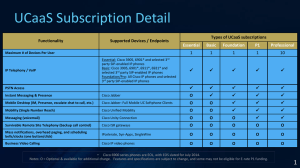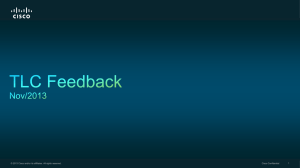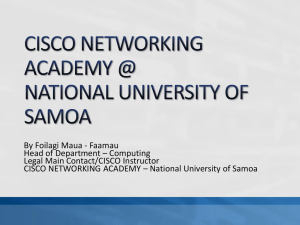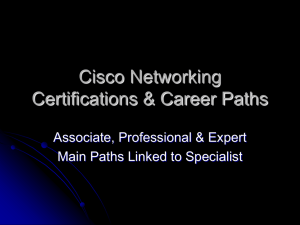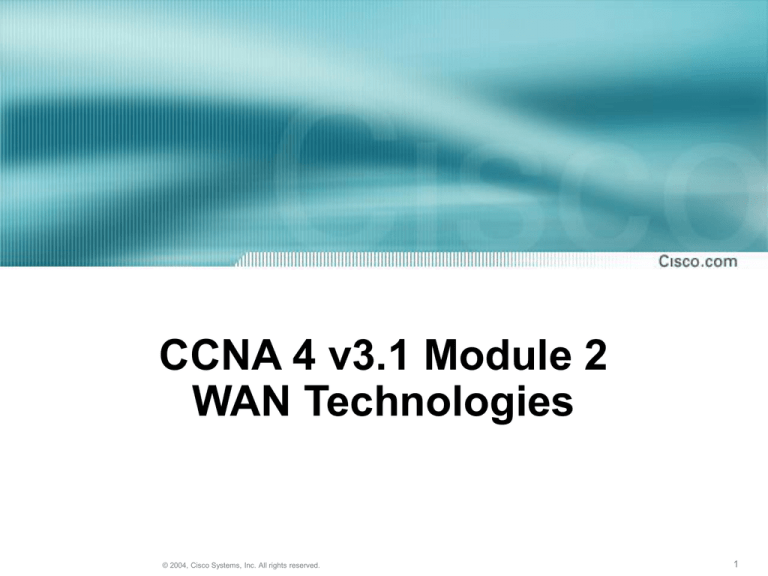
CCNA 4 v3.1 Module 2
WAN Technologies
© 2004, Cisco Systems, Inc. All rights reserved.
1
Purpose of This PowerPoint
• This PowerPoint primarily consists of the Target
Indicators (TIs) of this module in CCNA version
3.1.
• It was created to give instructors a PowerPoint to
take and modify as their own.
• This PowerPoint is:
NOT a study guide for the module final assessment.
NOT a study guide for the CCNA certification exam.
• Please report any mistakes you find in this
PowerPoint by using the Academy Connection
Help link.
© 2004, Cisco Systems, Inc. All rights reserved.
2
To Locate Instructional Resource
Materials on Academy Connection:
• Go to the Community FTP Center to locate
materials created by the instructor community
• Go to the Tools section
• Go to the Alpha Preview section
• Go to the Community link under Resources
• See the resources available on the Class home
page for classes you are offering
• Search http://www.cisco.com
• Contact your parent academy!
© 2004, Cisco Systems, Inc. All rights reserved.
3
Objectives
© 2004, Cisco Systems, Inc. All rights reserved.
4
WAN Technology
© 2004, Cisco Systems, Inc. All rights reserved.
5
WAN Service Providers
© 2004, Cisco Systems, Inc. All rights reserved.
6
Physical Layer: WANs
© 2004, Cisco Systems, Inc. All rights reserved.
7
WAN Line Types and Bandwidth
© 2004, Cisco Systems, Inc. All rights reserved.
8
WAN Devices
© 2004, Cisco Systems, Inc. All rights reserved.
9
CSU/DSU
© 2004, Cisco Systems, Inc. All rights reserved.
10
Modem Transmission
© 2004, Cisco Systems, Inc. All rights reserved.
11
WAN Standards
© 2004, Cisco Systems, Inc. All rights reserved.
12
WAN Encapsulation
© 2004, Cisco Systems, Inc. All rights reserved.
13
WAN Data-Link Protocols
© 2004, Cisco Systems, Inc. All rights reserved.
14
Circuit Switching
© 2004, Cisco Systems, Inc. All rights reserved.
15
Packet Switching
© 2004, Cisco Systems, Inc. All rights reserved.
16
WAN Link Options
© 2004, Cisco Systems, Inc. All rights reserved.
17
WAN Link Options
© 2004, Cisco Systems, Inc. All rights reserved.
18
Analog Dialup
© 2004, Cisco Systems, Inc. All rights reserved.
19
ISDN
© 2004, Cisco Systems, Inc. All rights reserved.
20
ISDN
Router with
standard serial
interface,
connected to a
terminal adapter
© 2004, Cisco Systems, Inc. All rights reserved.
Router with native
ISDN BRI U or S/T
interface or PRI
21
Leased Line
• Leased lines are not only used to provide direct
point-to-point connections between Enterprise
LANS, they can also be used to connect
individual branches to a packet switched
network.
© 2004, Cisco Systems, Inc. All rights reserved.
22
WAN with X.25
• X.25 provides a low bit rate,
shared-variable capacity that
may either be switched or
permanent
© 2004, Cisco Systems, Inc. All rights reserved.
23
Frame Relay
• Most Frame Relay connections are based on PVCs rather
than SVCs.
• It implements no error or flow control. This leads to
reduced latency.
• Frame Relay provides permanent shared medium
bandwidth connectivity that carries both voice and data
traffic.
© 2004, Cisco Systems, Inc. All rights reserved.
24
ATM
• Asynchronous Transfer Mode (ATM) is a
technology capable of transferring voice, video,
and data through private and public networks.
• It is built on a cell based architecture rather than
on a frame-based architecture.
© 2004, Cisco Systems, Inc. All rights reserved.
25
DSL
• DSL uses existing twisted-pair telephone lines to
transport high-bandwidth data
• DSL service is considered broadband, as it uses
multiple frequencies within the same physical
medium to transmit data
© 2004, Cisco Systems, Inc. All rights reserved.
26
ADSL Technology
Splitter
• The local loop connects the splitter to the DSLAM
• DSLAM connected to ISP using ATM technology
• Voice and data use separate frequency ranges
(voice 0-4Khz, data 20Khx – 1Mhz)
© 2004, Cisco Systems, Inc. All rights reserved.
27
Cable Modem
• Enhanced Cable Modems enable twoway. High speed data transmissions
using the same coaxial lines that
transmit cable television.
© 2004, Cisco Systems, Inc. All rights reserved.
28
Cable Data Network Architecture
© 2004, Cisco Systems, Inc. All rights reserved.
29
Modern WAN
© 2004, Cisco Systems, Inc. All rights reserved.
30
WANs Operate at the Lower Three
Levels of the OSI Model
© 2004, Cisco Systems, Inc. All rights reserved.
31
Comparing WAN Traffic Types
© 2004, Cisco Systems, Inc. All rights reserved.
32
Steps In WAN Design
© 2004, Cisco Systems, Inc. All rights reserved.
33
WAN Topology
Star Topology
Full-Mesh Topology
Partial-Mesh Topology
© 2004, Cisco Systems, Inc. All rights reserved.
34
Three-Layer Design Model
• The links connecting the various sites in an
area that provide access to the enterprise
network are called the access links or
access layer of the WAN.
• Traffic between areas is distributed by the
distribution links, and is moved onto the
core links for transfer to other regions,
when necessary.
© 2004, Cisco Systems, Inc. All rights reserved.
35
Advantages of the Hierarchical Approach
• Scalability: networks can grow without sacrificing
control or manageability
• Ease of Implementation: clear functionality at each
layer
• Ease of troubleshooting: Isolation of problems in the
network is easier
• Predicatability network modelling and caapacity
plannng easier
• Protocol Support: mixing current and future
applications and protocols is easier
• Manageability: all the above improve the
manageability of the network
© 2004, Cisco Systems, Inc. All rights reserved.
36
Internet for WAN Connectivity
© 2004, Cisco Systems, Inc. All rights reserved.
37
One-Layer Hierarchy
© 2004, Cisco Systems, Inc. All rights reserved.
38
Using the Internet as an Enterprise WAN
• Enterprise WANs will have
connections to the Internet.
• This poses security problems but also provides an
alternative for inter-branch traffic.
• VPN technologies can solve security issues
© 2004, Cisco Systems, Inc. All rights reserved.
39
Summary
© 2004, Cisco Systems, Inc. All rights reserved.
40





